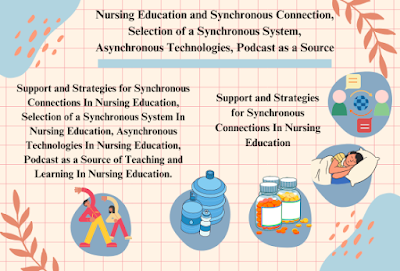The Synchronous Connection Selection of a Synchronous System Asynchronous Technologies Podcast as a Source In Nursing Education. Selection of a Synchronous System Nursing education continues to evolve with the advancement of technology.
The Synchronous Connection Selection of a Synchronous System Asynchronous Technologies Podcast as a Source In Nursing Education
In nursing education, synchronous learning involves real-time interaction between instructors and students, while asynchronous learning allows for self-directed learning at different times. Podcasts, as an asynchronous technology, can be a valuable addition to nursing education, allowing students to access learning materials whenever they want.
Synchronous methods, such as video conferencing, allow for live discussions and Q&A sessions, while asynchronous methods, such as podcasts, offer flexibility and the ability to work through the content at one’s own pace. The choice between synchronous and asynchronous approaches depends on the specific learning objectives, student needs, and available resources.
Both synchronous and asynchronous tools offer unique benefits that enhance teaching and learning experiences. As nursing educators explore these tools, it’s essential to understand the strategies and technologies that support their effective implementation.
Support and Strategies for Synchronous Connections in Nursing Education
Synchronous learning, where students and faculty interact in real-time, is increasingly used in virtual classrooms. Despite the differences in technologies (e.g., video conferencing, webinars), the core requirement remains the same: careful planning and support. Effective virtual teaching demands strategic preparation to facilitate learning over distances.
Instructors must ensure students are familiar with the technology, clearly communicate expectations, and foster an environment conducive to learning. Orientation to the synchronous tools is critical, as it directly impacts student success and confidence in the online learning environment. Clear and concise instructions are essential to improve students’ academic self-concept and outcomes.
Like traditional teaching methods, synchronous technologies require marketing, site selection, communication, and course coordination. Collaboration between faculty and administrators is vital to ensure the seamless operation of synchronous systems.
Selecting the Right Synchronous System for Nursing Education
Choosing the best synchronous system for nursing education varies depending on institutional resources and student demographics. If a school already has regional video conferencing systems, integrating them into the virtual classroom can be straightforward. In rural areas or places with limited broadband access, remote video conferencing units in hospitals or libraries offer students an alternative to high-speed internet at home.
For students with reliable internet, web conferencing systems provide flexible access to virtual classrooms. Many institutions subscribe to specific products, making it cost-effective to utilize existing systems. While video quality may not always allow for detailed facial recognition, it still offers a degree of face-to-face interaction that is essential in nursing education.
When selecting a synchronous tool, consider the number of participants. For larger groups, switching to a webinar format may be necessary, although this comes at the cost of two-way interaction. Additionally, the growing use of smartphones and tablets means that web conferencing tools should accommodate mobile devices, as students often use multiple internet-connected devices for learning.
Asynchronous Technologies in Nursing Education
Asynchronous learning tools, which allow students to access content at their convenience, are gaining traction alongside synchronous systems. These technologies offer unmatched flexibility, as students are not tied to a specific time or place. Audio-only and video-enhanced content can be delivered to learners on their own schedules, allowing them to engage with materials at their own pace.
Podcasting as a Teaching and Learning Tool in Nursing Education
One popular asynchronous tool in nursing education is podcasting. Originally derived from Apple’s iPod, podcasts now refer to any type of downloadable audio programming that can be accessed on various devices. Podcasts are commonly delivered in mp3 format, and students can subscribe to receive new content automatically.
Faculty can easily capture live lectures for podcasting using portable audio recorders, making them available for students to review later. This is especially helpful for reinforcing difficult concepts or providing extra time for note-taking. Lectures can be archived and reused, reducing the impact of faculty absences or inclement weather on class schedules.
However, podcasting alone has limitations. While it offers students a chance to review material, it does not promote active learning. Additionally, some students may perceive podcasts as an opportunity to skip live classes. To mitigate this, educators should incorporate interactive learning activities that build upon the podcast content, ensuring students remain engaged.
Leveraging Podcasts to Enhance Learning
Podcasting can extend beyond simply recording lectures. Supplementary podcasts can provide students with deeper insights, answer frequently asked questions, or feature guest speakers to enrich the learning experience. Weekly reviews of key topics or “pre-casts” of materials before class sessions can also help students better prepare for live discussions.
Pre-casting, often referred to as a “flipped classroom” approach, allows instructors to deliver lecture-style content ahead of time, reserving class periods for more interactive and engaging learning activities. This method has proven effective in maximizing class time for higher-order learning tasks, such as problem-solving and critical thinking.
Conclusion
Both synchronous and asynchronous technologies offer valuable tools for nursing education. Synchronous systems bring the benefits of real-time interaction, while asynchronous tools, like podcasts, offer flexibility and supplementary learning opportunities. By selecting the right combination of technologies and strategies, nursing educators can create a more dynamic and effective learning environment for their students.
Read More:
https://nurseseducator.com/didactic-and-dialectic-teaching-rationale-for-team-based-learning/
https://nurseseducator.com/high-fidelity-simulation-use-in-nursing-education/
First NCLEX Exam Center In Pakistan From Lahore (Mall of Lahore) to the Global Nursing
Categories of Journals: W, X, Y and Z Category Journal In Nursing Education
AI in Healthcare Content Creation: A Double-Edged Sword and Scary
Social Links:
https://www.facebook.com/nurseseducator/
https://www.instagram.com/nurseseducator/
https://www.pinterest.com/NursesEducator/
https://www.linkedin.com/in/nurseseducator/
https://www.researchgate.net/profile/Afza-Lal-Din
https://scholar.google.com/citations?hl=en&user=F0XY9vQAAAAJ
